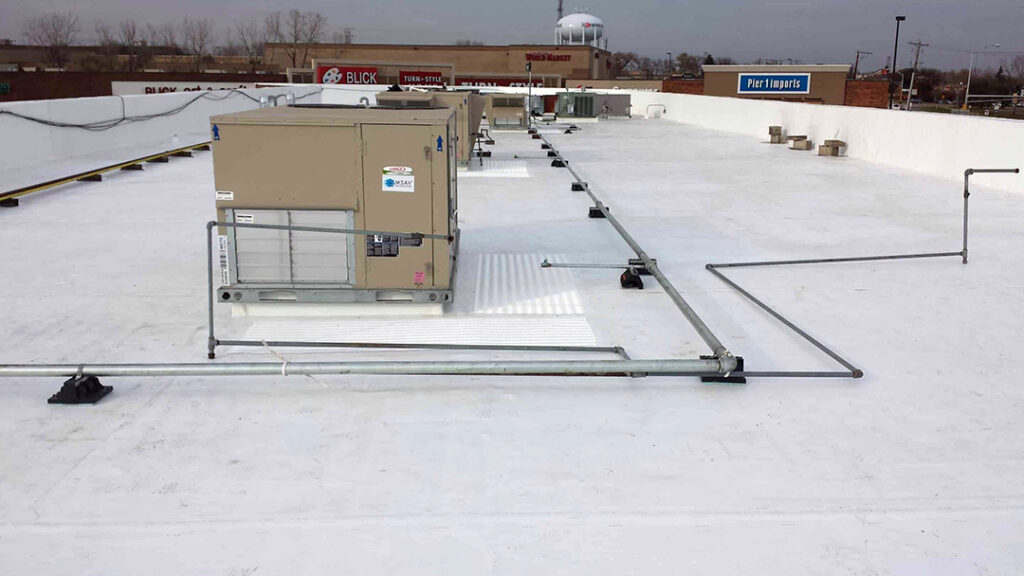Before we dissect the advantages of each roofing material, it’s essential to grasp their core capabilities. Understanding TPO and EPDM, belong to the same thermoset synthetic rubber family, but they have unique compositions and characteristics.
Unveiling TPO’s Strengths
TPO is a single-ply membrane composed of ethylene propylene rubber and polypropylene that’s reinforced with polyester. Its white reflective surface offers excellent UV resistance, making it a popular choice for energy-efficient “cool roofs.” TPO is also known for its weldability, resulting in a strong, monolithic bond, and its resistance to tears and dirt build-up.
EPDM: The Time-Tested Standard
EPDM, introduced in the 1960s, is a black synthetic rubber membrane. Its excellent resistance to ozone, weathering, and abrasion has earned it a reputation for longevity and low maintenance. Aided by liquid adhesives or specially formulated tape, EPDM offers a simple and quick installation process.
Installation and Application: Speed Vs. Precision
This video uploaded by GAF Roofing, provides a great overview of How to Install Low-Slope Roofing and TPO Best Practices.
When comparing TPO and EPDM, the installation process is a great starting point. Not only does it influence the final output, but also the labor costs associated with each material.
The Swift Application of EPDM
EPDM’s characteristic rolls can be installed with relative ease. The installation process for EPDM is straightforward, especially when it comes to seaming. EPDM membranes can be installed using ballasted, fully adhered, or mechanically attached systems, offering versatility to match different building structures.
TPO: A Precision Job
The hot-air welding method used to seal TPO seams demands technical expertise. While it increases installation time and cost compared to EPDM, TPO’s ability to form a seamless barrier around rooftop penetrations is unparalleled. This precision results in fewer future leaks and a neater, more professional-looking roof.
Long-Term Performance and Durability
Investing in a commercial roofing system is an investment in the longevity of the building. Let’s evaluate how TPO and EPDM measure up over time.
The Resilience of TPO
TPO’s resistance to mold, algae, and punctures helps maintain its integrity over the years. When properly installed, TPO can withstand the test of time, performing well against the elements and ensuring minimal roof maintenance for the building owner.
EPDM’s Longevity
EPDM is often praised for its life expectancy of 30 years or more, thanks to its stable material composition. The seamless application (when done correctly) provides a reliable barrier against water infiltration. The longevity of EPDM makes it an appealing option for those looking for a low-cost, low-maintenance roofing solution with a proven track record.
Environmental Impact and Sustainability: A Green Perspective
As environmental consciousness continues to shape decisions across all industries, the green factor of roofing materials cannot be overlooked.
TPO’s Environmental Profile
The reflective and emissive properties of white TPO roofs contribute to building energy efficiency, especially in warmer climates. Reduced heat absorption can lead to lower cooling costs and lessen the urban heat island effect. Moreover, TPO systems are often recyclable, adding to their green credentials.
EPDM: A Legacy of Sustainability
EPDM sheets are largely composed of natural gas and crude oil, and some formulas incorporate recycled materials. Although not typically reflective, EPDM can be paired with light-colored coatings to improve energy efficiency. Its long lifespan and the potential for reclamation and recycling at the end of service life underscore its sustainability.
Cost Considerations in TPO vs. EPDM
Every roofing project involves a careful balance of cost and quality. Here, we break down the financial components of choosing TPO over EPDM and vice versa.
The Cost of TPO
At the outset, TPO installation tends to be slightly more expensive than EPDM due to the higher material cost and the technical skills required for installation. However, the energy savings over the building’s lifetime can offset this upfront expense, making TPO a cost-effective long-term solution.
EPDM: An Affordable Option
EPDM’s simplicity and speed of installation can translate to lower labor costs, making it an attractive choice for projects with tight budgets. Additionally, EPDM’s material cost is generally lower than TPO’s, especially in the black variant. Its ability to resist aging, cracking, and shrinking helps maintain these initial cost savings over time.
Maintenance and Reparability: Post-Installation Challenges
Roof maintenance is a reality for every property owner, so the ease and cost of maintenance are crucial in the TPO vs. EPDM decision.
TPO’s Reparability
One of the main advantages of TPO in terms of maintenance is its ease of repair. Damaged areas can usually be cut out and replaced with new material, and the heat-welded seams make repairs almost as strong as the original installation.
The Resilience of EPDM
EPDM’s resistance to scuffs and tears in common maintenance scenarios makes it a low-maintenance option for large, flat roofs. Its straightforward repair process further reduces costs and inconvenience, making it an excellent choice for budget-conscious clients.
Weather Resistance and Climate Considerations
Each roofing material performs differently in response to various weather conditions, which is a significant factor in material selection.
TPO: A Hot Climate Champion
TPO is highly resistant to UV radiation, making it an ideal candidate for regions with intense sunlight. Its reflective surface can significantly reduce the heat island effect. TPO’s resistance to thermal expansion and contraction further cements its popularity in warmer climates.
EPDM’s Cold Weather Edge
EPDM excels in cold-weather resilience, retaining its pliability and protective qualities under freezing temperatures. This makes it particularly suitable for regions with harsh winters or where significant temperature fluctuations are the norm.
Customer Preferences and Market Trends
Understanding customer preferences and keeping an eye on market trends can make the difference between good and great service delivery.
Meeting Customer Expectations
The modern customer is well-informed and may come to the table with preconceived ideas about these materials. It’s vital to communicate the strengths and limitations of both TPO and EPDM clearly to align client expectations with the chosen material.
Staying Ahead of Market Shifts
As technology and customer preferences evolve, the roofing market continually shifts. TPO has gained considerable market share due to its thermal and energy efficiency, while EPDM remains a trusted and cost-effective solution for many projects. Keeping abreast of these market trends ensures that the services provided remain competitive and relevant.
Regulatory Compliance and Local Restrictions
Local building codes and regulatory requirements play a significant role in material selection and should not be overlooked.
Adhering to Local Regulations
Understanding the local regulatory landscape is crucial. Some areas may have specific requirements or recommendations for roofing materials based on environmental or safety concerns. Ensuring compliance with these regulations can be a decisive factor in choosing between TPO and EPDM.
Navigating Certification Requirements
Both TPO and EPDM may need to meet certain certifications or standards. Being knowledgeable about these requirements can streamline the material selection process and prevent costly revisions later.
The All-Important Decision: TPO or EPDM?
When it comes down to it, the choice between TPO and EPDM is unique to each roofing project. A complex interplay of factors, including client needs, budget, weather conditions, and long-term goals, informs this decision.
Professionalism, customer service, and a commitment to quality are at the heart of every decision made by roofing contractors. It’s these values that guide recommendations, ensuring that the chosen material not only meets the project’s current needs but also sets the foundation for a long-lasting, reliable roof.
For professional expertise and dedication to superior roofing solutions, look no further than Allweather Roof, a leading commercial roofing contractor in Golden Valley, Minnesota. Their track record of excellence and customer-centric approach makes them the ideal choice for your next roofing project.





